 |
Centre for Australian National Biodiversity
Research
|
CPBR NEWS
Issue 58- February 2003
News from the Centre for Plant Biodiversity Research, Australian National Herbarium (CANB), for the information of CPBR and ANBG staff and volunteers.
CPBR News is produced monthly. If you wish to contribute, please email your suggestions to Val Oliver, the coordinator.
Val Oliver: ph (02) 6246 5533; fax (02) 6246 5249; email: Val.Oliver@csiro.au
1. Staffing News
Jan Wilson retires after 21 years at ANBG
Jan Wilson retired on 30 January 2004 after more than 21 years of service to the Australian National Botanic Gardens and more recently the Centre for Plant Biodiversity Research.
Jan joined the Botanic Gardens as a temporary switchboard operator in July 1982, and her short-tem contract was continually extended till the months grew to years and eventually she became a permanent public servant.
Jan was not the sort of person who could never ‘do nothing’ while waiting for the next phone call, and, as she shared an office with some cabinets full of photographs of Australian native plants, she took on the job of updating the catalogue of this collection on index cards. The curation and marketing of this Photograph Collection became Jan’s main job over the next 21 years.
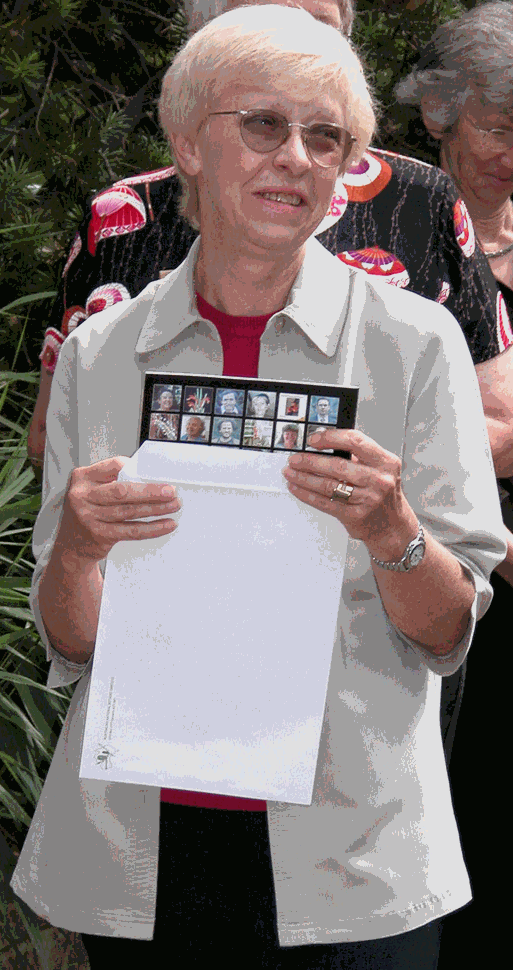 Jan
was a very competent typist and it was not long before she was also performing
a vital role in the preparation of educational exhibitions at the Gardens
by type-setting captions on a now ‘extinct’ piece of equipment called
an IBM Composer. Her involvement permeated all aspects of exhibition preparation
and she was one of the team of four who worked day and night to prepare for
the opening of the new Visitor Centre at the Gardens by the Prince and Princess
of Wales in 1985.
Jan
was a very competent typist and it was not long before she was also performing
a vital role in the preparation of educational exhibitions at the Gardens
by type-setting captions on a now ‘extinct’ piece of equipment called
an IBM Composer. Her involvement permeated all aspects of exhibition preparation
and she was one of the team of four who worked day and night to prepare for
the opening of the new Visitor Centre at the Gardens by the Prince and Princess
of Wales in 1985.
Jan was also interested in fostering the interest of young people in the environment and she came up with the idea of natural history trails for the very young at the Gardens. The first of these was based on the book, ‘Leaftail the Gecko’, and involved a series of model gecko lizards which Jan made at home and installed, along with other props, in the Rainforest Gully. This trail was an instant success and set the tone for a range of later trails for which Jan made models and props.
She also set up a database of botanic gardens throughout Australia which became the basis of the commercially published full-colour book ‘Botanic Gardens of Australia – a Guide to 80 Gardens’, the first book to ever document our regional botanic gardens.
But it is the Australian Plant Image Index, as her photo collection became, that most people will associate with Jan’s known ongoing contribution to Australian botany. This collection is now a vital part of the Gardens three main collections, along with the Living Plants and the scientific Herbarium specimens with which it is linked by a shared database. Over the years she has worked to encourage donations to the collection via the Government’s ‘Cultural Gifts Program’ of tax deductability for donations to the collection and to promote its use as a source of environmental photos for government and industry in Australia and overseas via the Internet.
In recognition of Jan’s considerable contribution to the Australian National Botanic Gardens and her work on the photo collection Jan was awarded an Australia Day Achievement Award by the Department of the Environment and Heritage.
[Murray Fagg]
********************
Ode to Herbaria
The following may be of some interest; it's not everyday you see poems about herbaria. The author is unknown, but it appeared in: Putnam's Monthly Magazine of American Literature, Science and Art 4 (24): 632 (Dec 1854).
------------------------------------------------------
TO MY HERBARIUM
Ye dry and dead remains!
Poor, wrinkled remnants of a beauteous prime!
Why, from your final doom, should I take pains
To stay the hand of time?The world would pass you by:
For beauty, grace and fragrance all are gone.
Your age is homeliness to every eye,
And prized by me alone.Not beautiful, but dear,
Your wrecks recall to me the happy past.
Wand-like, your stems can summon to appear
The days that could not last.I breathe the summer air!
I wander in the woodland paths once more
Again the copse, the dell, the meadow, wear
The loveliness of yore.Turned to the God of day,
Your little lips come, prayerfully, apart.
with the soft breeze your leaves, reviving, play
Sweet music to my heart.The friend who in those years
Shared warmly in my rambles far and wide,
Back, with the same old fondness re-appears,
And trudges at my side.These are your charms to me!
While such dear recollections ye awake,
Your ruins, blackened, crumbling though they be,
I treasure for their sake.May I, like you, dry flowers,
When in young life I can no more engage,
A dear memento be of happy hours
To those who tend my age.
[Article submitted by Jim Croft]
********************
2. General Centre matters
Recent ABRS Publications
A Field-Guide to the Mosses and Allied Plants of Southern Australia David
Meagher & Bruce Fuhrer
FLORA OF AUSTRALIA SUPPLEMENTARY SERIES NUMBER 20
Published by ABRS, Canberra and Field Naturalists Club of Victoria, Blackburn
(2003)
Available from ABRS: $48 (incl. postage and GST)
This is a richly illustrated identification guide to almost 500 mosses, liverworts
and hornworts in southern Australia. The book includes an introduction to
the bryophytes, information and hints on the collection, storage and identification
of specimens, indentification keys, descriptions, thumb-nail anatomical sketches
and more than 250 superb, half-page colour photographs.
Catalogue of Australian Liverworts and Hornworts
Patrick M. McCarthy
FLORA OF AUSTRALIA SUPPLEMENTARY SERIES NUMBER 21
Published by ABRS, Canberra (2003)
Available from ABRS: $25 (incl. postage and GST)
150 genera and 869 accepted species and infraspecific taxa of liverworts and
hornworts are listed from the eight States and mainland Territories of Australia.
Genera and species are listed alphabetically, and all synonyms that have been
applied to Australian specimens are inserted under the appropriate accepted
name. Nomina nuda, names of uncertain application and those reported
in error from Australia are appended. Each species entry is accompanied by
a chronological list of post-1982 literature citations that provide locality
details, descriptions, identification keys and/or habitat information.
This reference work completes a modern trio of catalogues on the Australian lichen and bryophyte floras, together comprising more than 5,000 taxa and representing a significant component of the national biota.
[Patrick McCarthy]
********************
3. Research Groups
Asteraceae (Sunflower) tribe Gnaphalieae
I have recently started a post-doctoral fellowship with Randy Bayer focusing on the systematics and biogeography of the Asteraceae (Sunflower) tribe Gnaphalieae. The Gnaphalieae (everlastings, paper daisies, cudweeds) is a large tribe of sunflowers often used as medicinals, garden ornamentals and dried for decorative and floral arrangements. The tribe has approximately 187 genera and 1250 species, and although found worldwide, has its greatest diversity in Australia, southern Africa, and South America. The evolutionary relationships among the genera are not well understood and the last major comprehensive treatment of the tribe (Anderberg, 1991) has created a fair bit of controversy among specialists of the Gnaphalieae. The first goal of this research is to test the proposals of Anderberg by the use of DNA sequence data from multiple gene and genic regions. The age and distribution of the Gnaphalieae is also of great interest. The Asteraceae is estimated to be approximately 38 million years in age and historical biogeography indicates that major dispersals in the family were most likely after the separation of the Gondwanan super-continent. The second major goal of this project is to propose a biogeographic hypothesis for the tribe by use of the DNA sequence data to aid in explaining the current geographic distribution of the Gnaphalieae and aid in identifying the evolutionary and geological processes that have led to it. A better understanding of the evolutionary relationships and biogeography of the Gnaphalieae will allow for it to serve as a model for other studies in the Asteraceae, as well as aiding in further potential exploitation of horticultural and other uses of Gnaphalieae species.
[Matthew Unwin]
********************
Flora of Australia online
The Australian Biological Resources Study is pleased to announce that eleven volumes of the Flora of Australia are now available online. This is a world first for delivery online of an interactive, flora resource at a national level with a flexible, user-defined search interface. This online resource is a result of collaboration between the Australian Biological Resources Study and national and international botanical communities and institutions.
The search interface allows users to customise data delivery to suit their own needs. You can limit your display, for example, to just species lists, to habitat, or you can retrieve the full set of information for a taxon. Electronic distribution maps and much of the line art from the books is also online. Around 8,500 taxa have been published so far in the Flora of Australia book series, and to date 4,500 of these are available in Flora of Australia online. There are three web sites for the information and their addresses follow:
(Flora of Australia volume 49: Norfolk, Lord Howe and surrounding Islands);
(Flora of Australia volume 50: the remaining Oceanic Islands);
(Information for over 50 families extracted from the following nine volumes of the Flora of Australia book series: 3, 11A, 11B, 12, 16, 17A, 17B, 35 and 48).
[Helen Thompson]
********************
Botanical Internship Program
Hall of Shame 2004
Once again it was another fun filled adventure to Jervis Bay with the 2004 interns. And while the plants are the main focus of the trip, one can’t help but notice the occasional animal behaviour. Notable mentions for this year Hall of Shame are…
On the way there…
The driver of the truck who almost wiped out Anthony’s Tarago because he dropped something down his pants and was too busy looking for it.
The Visitor Information Officer at Fitzroy Falls asking for an impromptu workshop on "how to use the AVH", thus making everyone half an hour late for lunch on the first day.
The driver of Truckasaurus (a weird tractor with spikes all over) and Anthony for giving the Interns a modern day version of the Ben Hur chariot scene on the streets of Nowra.
Irish rock group U2 for giving the opportunity to Andrew and Chris to sing in a falsetto voice.
Hayley for mishearing Brownyn and Naomi talking about Banksia cones and saying "yes they do look like little penises".
At the field station…
Naomi for patiently waiting outside three empty toilets for at least five minutes.
Anthony for taking the male vs female Trivial Pursuit game a little too seriously and making a scorecard on the blackboard of who actually won. Lee for insisting a mudskipper is in fact an amphibian! Read the card Lee, it’s a fish.
Naomi for completely freaking out after discovering a tick on her arm and Andrew for volunteering to look for more down her pants.
Hayley for handing Naomi a tube of Deep Heat to 'soothe' her sunburn.
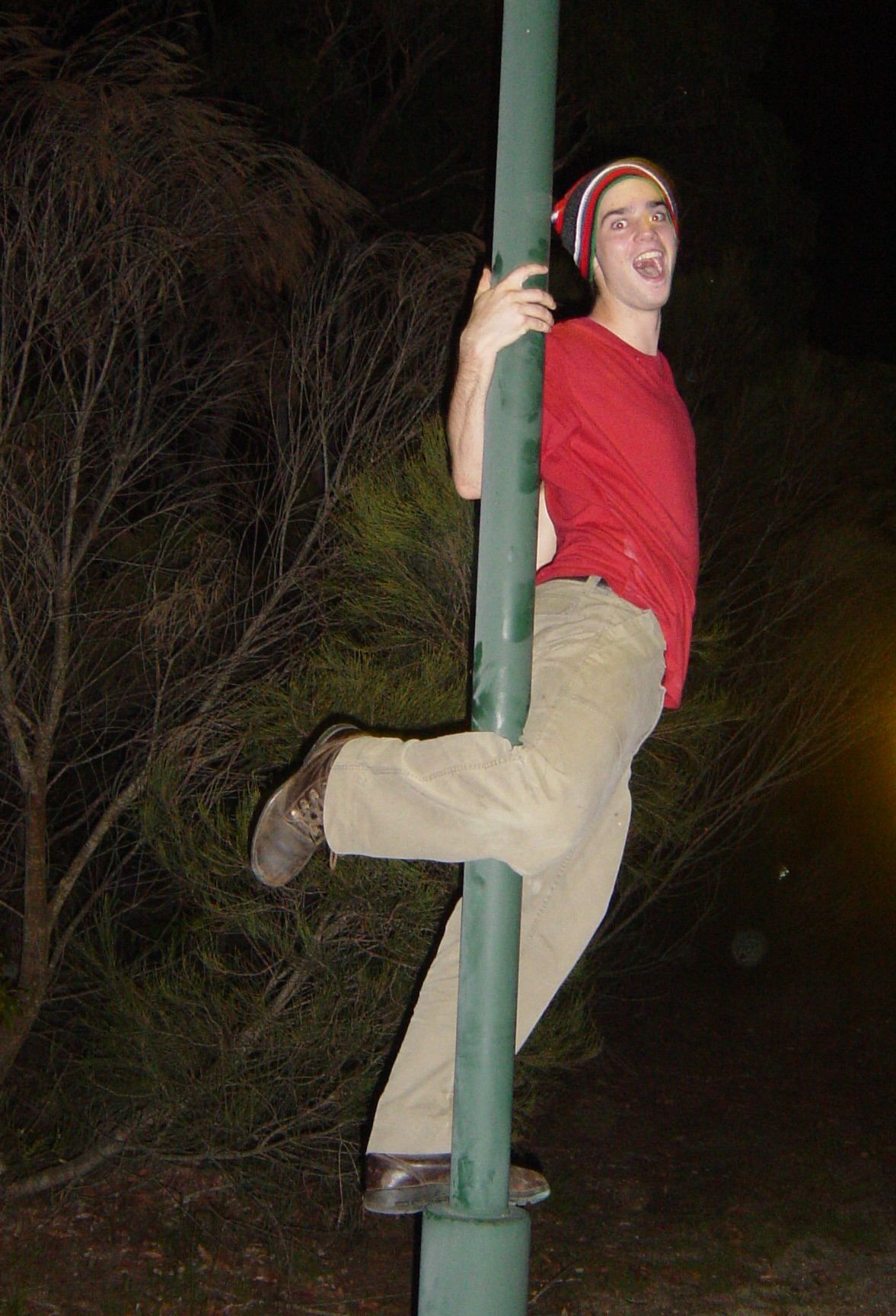
Owen "Pole Boy" Harrod showing that if he doesn’t get a job as a botanist he can always fall back on a trade.
The music…
Andrew for the greatest knowledge of how to play half a song on an acoustic guitar in the world. Chris for attempting Death Metal classics on an acoustic guitar.
Chris, Conny and Andrew for bringing enough guitars to start a sizable prog rock band.
Lee for misreading Brendan’s Wailers t-shirt as The Waifs and his L7 shirt as U2.
The Ramones for introducing every song with 1,2,3,4 count so that Brendan and Chris knew what beat to nod their heads at.
Jacqui and Bronwyn for failing Elementary Rock ‘n’ Roll 101 by failing to recognise that at least one of the members of the Jimi Hendrix Experience was black.
Heather for showing that you can take the girl out of Queensland but you can’t take the Queensland out of the girl by playing the twangy hillbilly mouth thingy.
The food…
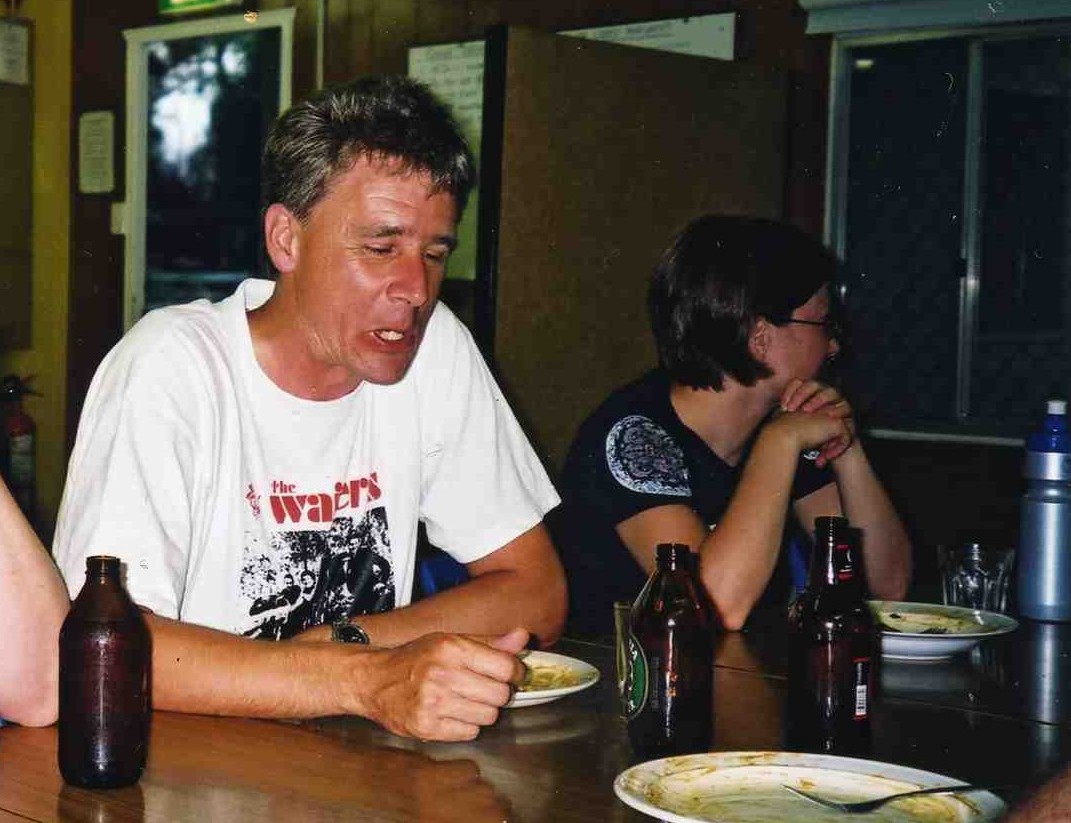
Brendan choking down what Lee generously describes as "field cuisine"
Lee for not cooking enough real food but buying one muesli bar for every man, woman and child in Australia (we still have a few boxes left!).
Heather for a vegan slant on proceeding by toasting grapes instead of marshmallows over the fire, resulting in slightly warmed grapes.
At the beach…
Paul for his orange-cheddar coloured shorts and Kim and Dave for wearing black budgie-smugglers on the beaches of Jervis Bay.
Brownyn for being possibly the first person in the world to almost die from being stung by a bee while swimming in the ocean … and her general red-neck views.
Heather for refusing to go for a swim because it was "too cold", despite the ocean being a balmy 24 degrees.
In the field…
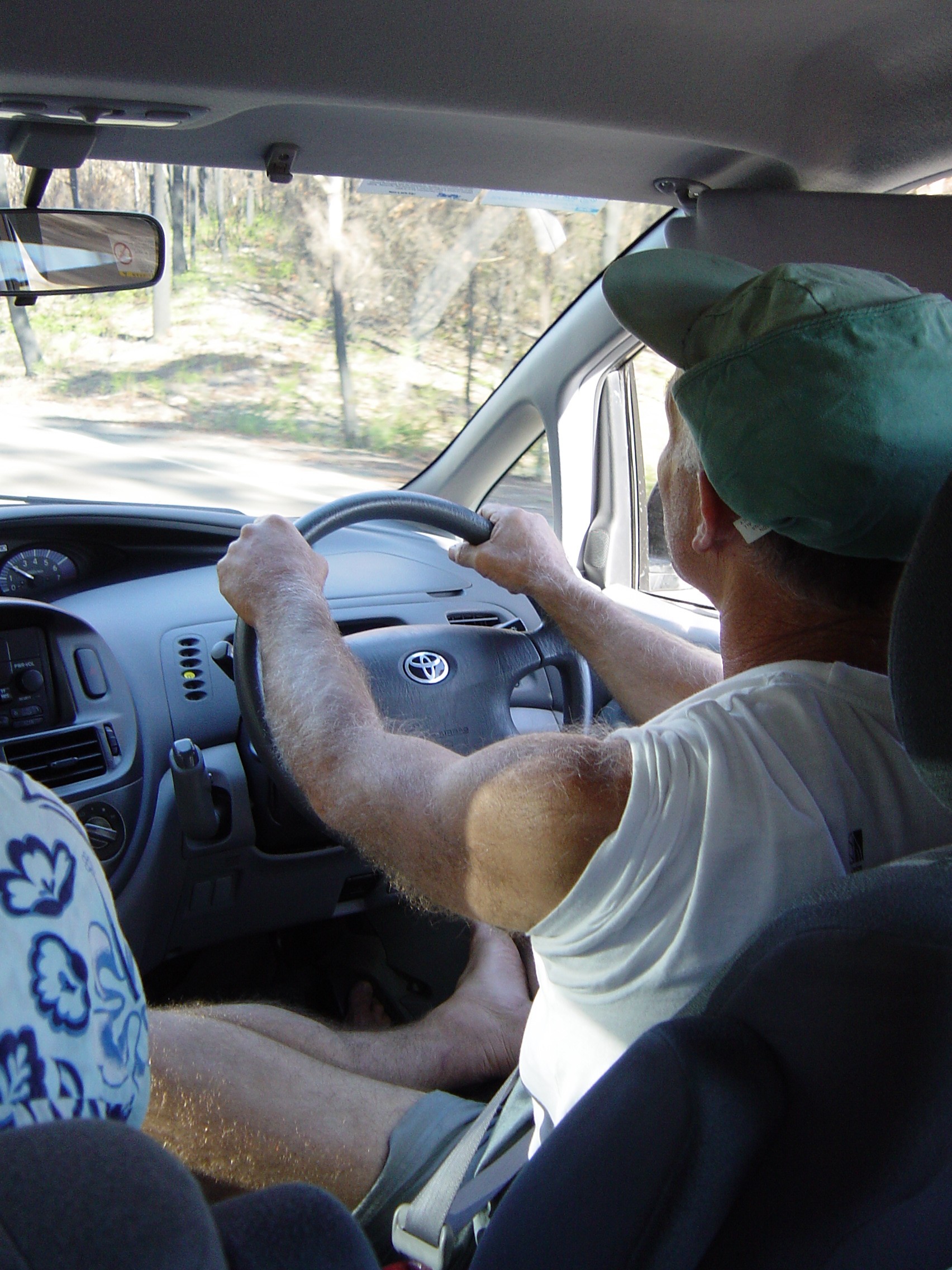
Still a country boy … Dave driving "side-saddle".
Dave and Brendan for continually disappearing/reappearing or talking in low (but distracting) voices at the edge of guest presentations.
Jemma for filling one of the 4WD’s with her collections of "interesting rocks"
Dave for:
-
throwing rocks during Malcolm Gill’s talk
-
chasing a bird away and then looking at it from further away with binoculars at Green Patch
-
posing seductively during the Intern’s speeches, inspecting the contents of the lab cupboards and winking at some of the Interns.
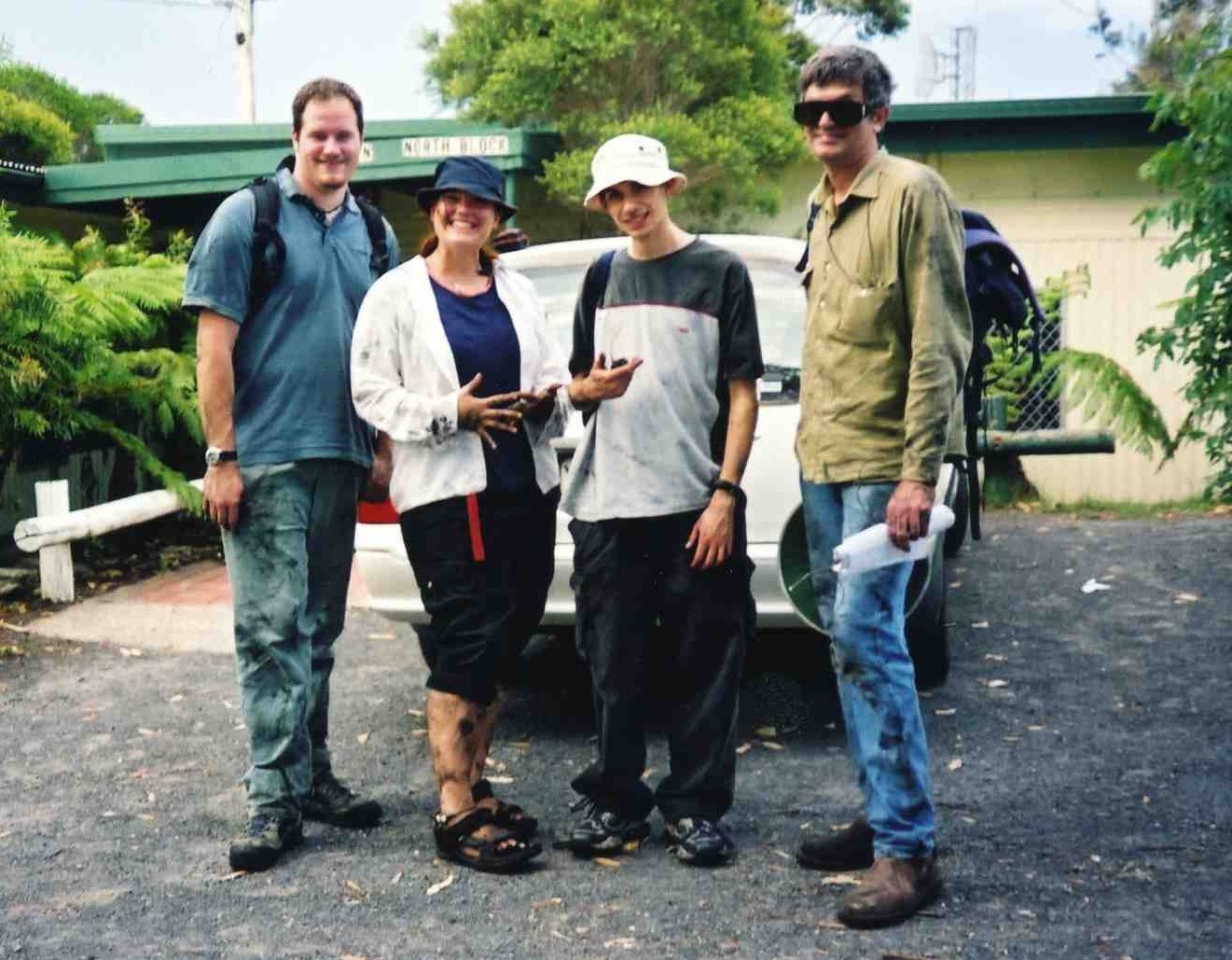
The Charcoal Chicken award to Chris,
Conny, Robert and Paul for completely
covering themselves black whilst finding the wrong plant
On the way home…
Anthony for laying rubber on every corner and roundabout from Canberra to Jervis Bay and back. Anthony’s bus for transforming into a techno dance floor at every major traffic light on the Princes Highway.
Jemma for wanting to stop at every "photo opportunity" from here to eternity.
Conny for telling Andrew and Chris to shut up, not appreciating the fact that people would pay good money to hear that kind of singing and champagne comedy. Five hours of which is barely enough!
Lee for being caught in possession of boxes inscribed with"Food leftovers from Jervis Bay Intern trip - keep for next year".
Robert for asking all staff for a written reference for an application that had to be in on Sunday at 4:45pm on the Friday.
Special mention to…
Jacqui for her dedication, missing both her daughter and husband’s birthdays to come on the field trip.
The Oliver award ("please sir, may I have some more?") to Brendan for his large second helpings. Anthony for having the audacity to have a "first serve" when Brendan was keen for seconds.
Andrew for relentlessly trying to get into the Hall of Shame, only to end up writing up most of it.
But the winner of the Hall of Shame for 2004 is …
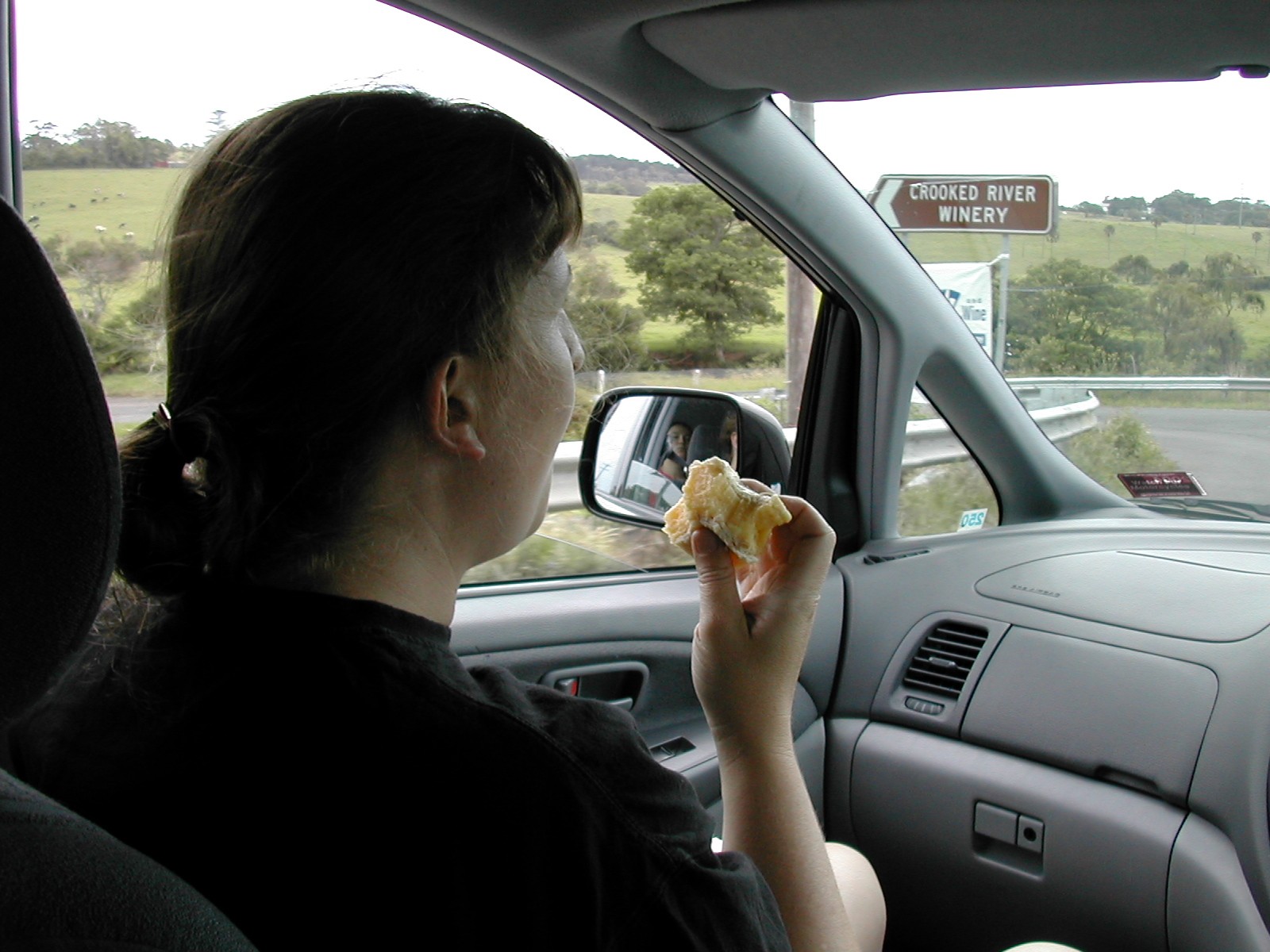
Jacqui for informing her driver "I am feeling a little car sick this morning", then … purchasing a rather rich vanilla custard slice and consuming it before being driven up the windy roads of Jamberoo Pass, whilst Chris and Andrew coincidently discussed "ways you can be sick"! Thanks for holding it in Jacqui. Anthony.
[Anthony Whalen]
********************
4. General Centre Matters
Program Review 2003-2004
The annual Program U Review will take place on Tuesday 9 and Wednesday 10 March in the Discovery Lecture Theatre. A timetable of presentations by staff is provided on the following pages and Centre staff are welcome to attend.
TIMETABLE
Program U Australian Flora Resources and Management Review
March 9 & 10 2004
DISCOVERY LECTURE THEATRE
Tuesday 9 March
|
Time |
Speaker |
Title |
|
9.00 |
Andrew Young |
Introduction |
|
Subprogram UA |
||
|
9.10 |
Curt Brubaker |
UA Introduction |
|
9.15 |
Randy Bayer |
The Asteraceae and Citrus research group |
|
9.30 |
Matt Unwin |
Evolution, diversification, and biogeography of the Gnaphalieae |
|
9.45 |
Ed Cross |
The systematics of Rhodanthe |
|
10.00 |
Alex Roberts |
Molecular systematics of Acomis, Rutidosis and Leptorhynchos |
|
10.15 |
Tea/Coffee |
|
|
10.45 |
Marlene Van Der Merwe |
A phylogenetic study of the rust fungi |
|
11.00 |
Tupac Otero |
Coevolution between Pterostylidinae orchids and their mycorrhizal fungi |
|
11.15 |
Kelli Gowland |
Distribution of epiphytic Aeridinae orchids in SE Australia |
|
11.30 |
Mark Clements |
The Orchid Research group |
|
11.45 |
David Jones |
Interactive ID systems for Orchids |
|
12.00 |
Judy West |
Multiple access identification systems |
|
12.15 |
Lunch |
|
|
1.00 |
Teguh Triono |
Phylogeny and biogeography of Pouteria in Malesia and Australasia |
|
1.15 |
Ed Biffin |
Molecular systematics of Syzygium and its allies |
|
1.30 |
Lyn Craven |
Systematic studies in Myrtaceae and Malvaceae |
|
1.45 |
Sophie Bickford |
TBA |
|
2.00 |
Chris Cargill |
Hornworts of Malaysia, Australasia and SW Pacific islands |
|
Subprogram UC |
||
|
2.15 |
Jim Croft |
UC Introduction |
|
2.20 |
Murray Fagg |
ANH web applications |
|
2.35 |
Greg Whitbread |
ANH database applications |
|
2.50 |
Brendan Lepschi |
AVH/APNI progress |
|
3.05 |
Tea/Coffee |
|
|
Subprogram UB |
||
|
3.25 |
Peter Thrall |
UB Introduction |
|
3.30 |
Bo Wang |
Where did the Fov in Australian cotton fields come from and how did it become virulent? |
|
3.45 |
Augusto Becerra |
Can we use native Australian cotton to introgress Fov resistance into elite cotton cultivars? |
|
4.00 |
Andras Keszei |
The molecular background of defence chemical variation in Eucalyptus |
|
4.15 |
Curt Brubaker |
Evolution of agricultural genomes |
|
4.30 |
Tony Brown |
Glycine polyploid evolution |
Wednesday 10 March
|
Time |
Speaker |
Title |
|
Subprogram UB contd.. |
||
|
9.00 |
David Field |
Promotion of hybridisation in black gum due to fragmentation |
|
9.15 |
Linda Broadhurst |
Genetic and ecological viability in remnant plant populations |
|
9.30 |
Bob Godfree |
Ecological risk assessment of transgenic virus-resistant white clover |
|
9.45 |
Richard Groves |
Sleeper weeds – the quiet achievers |
|
10.00 |
David Bagnall |
Enhanced revegetation using symbiotic nitrogen-fixing bacteria |
|
10.15 |
Tea/Coffee |
|
Subprogram Overview and Discussion Sessions |
||
|
10.45 |
Tony Brown & Curt Brubaker |
UA |
|
11.15 |
Peter Thrall |
UB |
|
11.45 |
Jim Croft |
UC |
|
12.15 |
Judy West |
Healthy Country Flagship |
|
12.45 |
Andrew Young |
Wrap up |
|
1.00 |
BBQ Lunch – herbarium oak tree |
|
Important Notes:
-
Presenters please email your presentation to Terese Falconer for loading onto the Discovery computer system by lunchtime on Monday 8 March at the latest.
-
As the schedule is tight make sure that you do not run overtime with your talk. Work to the formula of 12 minutes of presentation and 3 minutes for questions.
-
Tea, coffee and biscuits will be provided at morning and afternoon breaks and we will finish with a BBQ lunch on Wednesday – to sign up for lunch put your name on the whiteboard in the Herbarium tearoom.
[Andrew Young]
********************
Executive Committee
The next meeting of the Executive Committee is scheduled for 17 March 2004.
[Val Oliver]
*******************
Updated 8 March, 2004 by webmaster